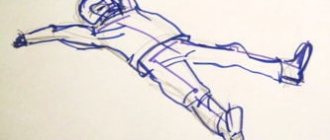Educational and game program “Such familiar and such interesting things”
Target:
revealing well-known things for children from an unusual side.
Objectives:
- introduce children to the history of the appearance of individual things;
— develop motor activity: agility, speed, coordination of movements;
- develop children's creative abilities;
- create a good mood in children.
Equipment:
paper clips, napkins, buttons, threads, tray, plastic utensils: plates, glasses, spoons, forks.
Progress of the event:
Host: In life we are surrounded by many different things. They all perform certain functions, that is, each is needed for something.
We all know very well that people eat soup with a spoon, draw or draw with a pencil, and wear a hat on their head. That's what a spoon is for? (children's answers)
But if you take a closer look at everyday things, it turns out that they contain a lot of interesting things: a spoon can turn into a tennis racket, and a hat into a butterfly net. If you apply your imagination, then familiar and, at first glance, boring things will become funny and interesting.
Today we will show our imagination, play with things that are familiar and familiar to all of you.
Paper clips
Host: What is this? That's right, a paper clip. What is it for?
A paperclip is one of the most versatile office tools. Both children and adults use it every day, but sometimes we don’t even think about where it came from and who invented it.
Historians know that our ancestors used pins to fasten various materials together back in the Bronze Age. This was about a thousand years BC. But the inventor of the paperclip is considered to be the Norwegian mathematician Johan Wohler, the year of invention is 1899.
Why did the paper clip appear only 100 years ago? It is difficult to imagine that such an elementary design could not have occurred to people before. Of course she could. There was just no particular need for a paper clip. Before its invention, pedantic office workers bound papers in stacks or rolls using ribbons or simply stitched them with thread. Then they came up with the idea of fastening it with sewing pins, but the volume of documents grew and something else was needed.
The idea of bending the wire several times and trying to fasten several papers with the resulting device came to the minds of three people at once. But only one person went down in history as an inventor. Wohler made sketches of his main invention - the “paleo-clip” - and in 1901 received a patent for it.
Wohler had no idea that paper clips were already being produced in Britain, moreover, more functional and practically significant. His paperclip design was less advanced. Since Wohler was an employee of the Brins patent office in Christiania (Oslo), he was well acquainted with patent procedures and patent law in Norway. By that time, several similar inventions had already been registered. And the paperclip in the form in which it now exists was invented in England, but for some reason no one ever patented this invention.
But Wohler's paperclip design had two drawbacks. Firstly, it wrinkled the paper because it pressed on it in too small an area, and secondly, it broke very quickly. The first drawback was quickly eliminated by coming up with the idea of making the wire in the form of various openwork patterns in order to distribute the load over a larger area. And to prevent the paper clip from breaking, special arms were welded to its ends.
As they say, there is no limit to perfection. The successors of Valera’s work also adhered to this principle. This is how chrome-plated, corrugated, smooth, colored, vinyl-coated plastic, triangular, and round square paper clips appeared.
Currently, about 20 billion paper clips are sold annually in the United States alone. Moreover, according to some studies, only no more than 5% of them are used for their intended purpose...
What can you do with paper clips if you use your imagination? (Children's answers)
It is used for dozens of different tasks: as a screwdriver, a poker chip, a toothpick or a master key... And today we will play with it.
Try to guess how many paper clips are in the box? (Children's answers)
Team competitions:
-In 30 seconds, assemble a chain of paper clips, whoever is longer.
— Draw a silhouette of a house using paper clips
- Lay out words from paper clips (house, cat, etc.)
- Relay the paper clips from one box to another.
Dishes
Presenter: At the beginning of the lesson, I talked about the spoon, how universal it is, and what is used to eat with a spoon? But the dishes also hide many secrets; the first shards were found back in the Stone Age. But today I want to talk about the history of disposable tableware. It appeared in the United States of America in 1910. Then the first patent was received for the production of disposable paper cups. Afterwards, the production of other tableware began - forks, plates, spoons, knives.
Mass production of disposable tableware arose in the late 1950s and early 1960s. Then the American William Dart produced the first disposable cup. In 1960, he created the Dart Container Corporation, which today controls about a third of the US disposable tableware and packaging market.
In the Soviet Union, the range of disposable tableware was limited to nondescript paper cups of very low quality. To use them for their intended purpose, it was necessary to take not one, but a couple of glasses at once, and place them one inside the other - this was the only way to avoid liquid leakage through the walls of the cups.
There were no other disposable tableware at that time. This was explained by the lack of demand for it, since fast food came to our country a little later.
At the beginning of the perestroika period, when small public catering began to develop, plastic disposable tableware began to be in demand. The cost of disposable tableware could be added to the cost of service and therefore some establishments even used it several times. The production of plastic and paper tableware that met the European quality level in our country began in the mid-1990s.
Consumers of disposable tableware include both people with low incomes and fairly wealthy citizens.
Why do you need dishes? And we will play with the dishes. First, let's give the items different names.
- a spoon (for example, a digger, a scoop, etc.)
- fork (picker, toother, etc.)
- mug (compoter, pourer, etc.)
Competitions:
- And now “Plate Thrower”: throw the plate as far as possible; as accurately as possible (on tray)
— Build a tower from cups
- Carry the napkin along the relay using a fork and spoon (without picking up the napkin).
Button
Host: There is one more thing that is familiar to us. Small, but so necessary. This is a button.
Instead of buttons, ancient people connected pieces of their clothing with plant thorns, animal bones and sticks. In ancient Egypt, buckles were already used, or one piece of clothing was threaded through a hole made in another, or the ends were simply tied together.
It is unknown who exactly invented the button: some scientists are inclined to believe that it was the Greeks or Romans, others that the button came from Asia. They were made mainly from ivory.
Buttons became widespread only in the 13th century. And almost until the 18th century they were a sign of wealth and noble origin: kings and the aristocracy could afford to order buttons made of gold and silver. At the beginning of the 18th century, buttons began to be made from metal and copper, but until almost the end of the 19th century, buttons were such an expensive product that they were altered from one garment to another.
In Russia, buttons have been known since the 6th century, but they were not always used for fastening. In Russian, this word correlates with “scarecrow”, “scarecrow”, “to frighten”. This is due to the fact that the Slavs attributed a protective and intimidating function to the button. Large amulets buttons, hollow, with some kind of pebble inside so that they would ring like bells, could simply be sewn to clothes - without a loop at all, and this role of the button for the time being was considered the main one in our country. And when such amulets fell out of use, Russia began to look up to Europe - in everything, including button fashion.
In English, “button” means “bud” - an unopened flower. This suggests that in Western Europe small parts of clothing served not a fastening, but an aesthetic, decorative function.
It is interesting that at first women completely ignored this invention and continued to use pins; only men were interested in buttons.
History remembers that the French king Francis ordered 13,600 gold buttons to decorate his velvet suit.
The position of a person was determined by the buttons. Buttons were made of gold and silver for nobles, of base materials for soldiers and servants, and of glass and wood for ordinary people.
On men's clothing the buttons are located on the right, and on women's clothing on the left. It is believed that at the time of the introduction of buttons, men dressed themselves, and women were dressed by maids - therefore, buttons were sewn on for them in a mirror image.
Finding a button is still considered a good omen, and if a black cat crosses your path, all you have to do is touch the button and you can safely move forward.
That's how many interesting things this small object contains. What can you do with it? (use as chips and tokens for board games, etc.). This is where there is room for imagination! And we will compete with you.
Competition:
- Count the number of buttons on the clothes of all team members.
- Throw the button into the glass.
— Pass the button along the relay race
- Make a necklace from buttons. Who is longer?
Presenter: This concludes our lesson. And remember, if you apply your imagination, then familiar and, at first glance, boring things will become funny and interesting.
But I hope you know that not all things can be played with. Do not take knives, scissors, needles, matches and other dangerous objects without the permission of adults.
Internet resources:
History of creation:
Paper clips https://istoriz.ru/skrepka-istoriya-izobreteniya.html
Disposable tableware https://www.omsb.ru/node/1298
Button https://shkolazhizni.ru/authors/zhabba/posts/4962/
https://luckytoys.ru/journal/view/istoriya_proishozhdenie_pugovitsy_155.html








